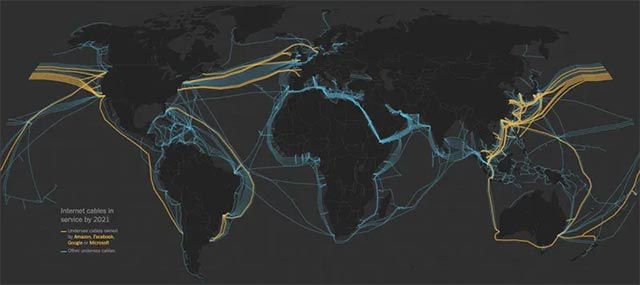Turn an undersea optical cable into a seismometer - why not?
Monitoring seismic activity worldwide is an important task, to do this requires installation of equipment at many different locations, regardless of complex terrain, in which the installation of Measuring systems in the undersea areas is the most difficult task. In fact, the ocean accounts for two-thirds of the earth, meaning most of our knowledge about seismic activity is limited to one-third of the planet's surface.
The installation of complex geological measuring systems on the ocean floor is difficult, but how to operate and maintain is even more difficult. To solve this problem, scientists from the University of California have come up with an initiative to turn existing undersea optical fiber lines into a seismic measurement network, contributing to an overview map. about the unprecedented state of the earth's tectonic movements on a global scale.

These undersea optical fiber systems connect every region of the execution, carrying vast amounts of data over long distances, forming an extremely important global internet connection framework. However, light is scattered and distorted if the cable moves or changes direction, which can occur in areas where the earthquake has occurred. By carefully monitoring the state of the light in the cable, scientists can fully determine exactly where the cable is bent (where the vibration appears) and to what extent - sometimes only in a few nanometers. In other words, researchers can look at a cable to find the source of seismic activity with an 'extraordinary' level of accuracy.
This technique is called Distributed Acoustic Sensing, and it basically transforms undersea fiber optic cables as individual motion sensors. A fiber optic cable can be divided into tens of thousands of segments, allowing to detect every slightest shift in the surface they attach to.
If successfully applied on a large scale, this technology can turn the undersea optical fiber network into a highly effective seismic measurement system on a large scale, while the location is reasonable to deploy.
 Successfully manufactured equipment to capture and separate CO2 from emissions for high efficiency and low cost
Successfully manufactured equipment to capture and separate CO2 from emissions for high efficiency and low cost Elon Musk's brainwave technology can cure autism?
Elon Musk's brainwave technology can cure autism? Adobe introduces a new tool that can detect whether photos have been taken or not
Adobe introduces a new tool that can detect whether photos have been taken or not Admire the robot model can transform itself as Transformer
Admire the robot model can transform itself as Transformer Connect seamlessly: Solutions to maintain a stable efficiency of your business
Connect seamlessly: Solutions to maintain a stable efficiency of your business Google announces the new Google Assistant with incredible speed
Google announces the new Google Assistant with incredible speed